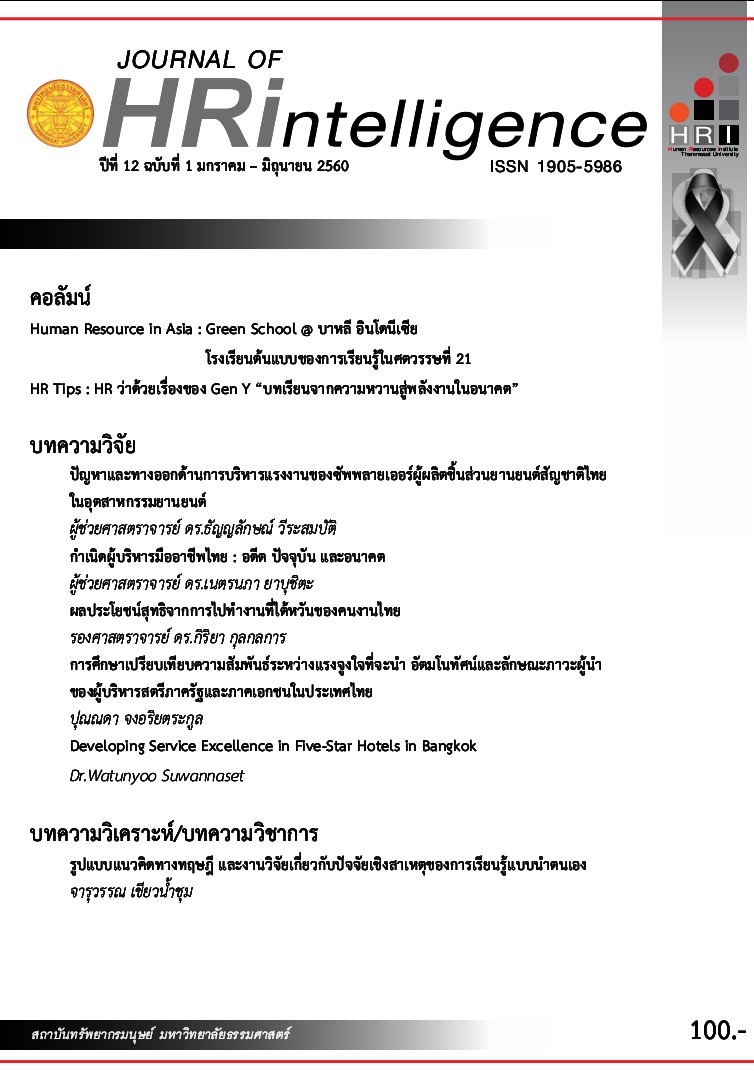The Rise of Thai Professional Managers : Past , Present , and Future
Main Article Content
Abstract
This paper presents evidences about the rise of professional managers in Thailand dating back to the start of industrialization according to the National Economic and Social Development Plans. Thai government has promoted the roles of private sector seriously since B.E. 2504 to the present, which has already entered the 12th National Economic and Development Plan (B.E.2560-2564). This study used quantitative research method based on three sets of secondary statistical data, including information on executives of private companies in B.E. 2530 published by the Manager Magazine (120 managers), profiles of the President or Chief Executive Officer (CEO) of the companies listed on the Stock Exchange of Thailand in B.E.2543 (259 persons) and B.E. 2559 (483 persons).
The results indicate that the professional managers of private companies in Thailand were divided into three groups, comprising (1) the owners or founders and their successors; non-family employed managers including (2) internally-promoted managers who entered the company at a bottom level and then climb up into top management positions, and (3) managers from the outside who entered directly into top management positions. Most Thai professional managers also obtained higher educational levels. Most have specialized in management, especially MBA. Over half graduated from abroad, especially the United States. However, the proportion of CEOs who were founders and their heirs are still high, reflecting a high degree of family control, which must face the problem of the decay of the third generation. It is required strategies to develop family enterprises to managerial enterprises as well as to constitute human resource management system for non-family professional managers to hand over the family business in the future.
Article Details
ขอมอบลิขสิทธิ์บทความที่ได้รับการตีพิมพ์ให้แก่สถาบันเสริมศึกษาและทรัพยากรมนุษย์ กรณีมีการฟ้องร้องเรื่องการละเมิดลิขสิทธิ์เกี่ยวกับภาพ กราฟ ข้อความส่วนใดส่วนหนึ่ง และ/หรือข้อคิดเห็นที่ปรากฎในบทความ ให้เป็นความรับผิดชอบของข้าพเจ้าและผู้เขียนร่วมแต่เพียงผู้เดียว
References
กองบรรณาธิการนิตยสารผู้จัดการ. (2530b, สิงหาคม). ผู้จัดการรุ่นใหม่ ในสายตา “ผู้จัดการ”. นิตยสารผู้จัดการ. 84-244.
กองบรรณาธิการนิตยสารผู้จัดการ, (2553, มกราคม). 1 ทศวรรษ Role Model. นิตยสารผู้จัดการ. 96-159.
กองบรรณาธิการนิตยสารผู้จัดการ, (2554, มกราคม). Role Model ก้าวปีที่ 11. นิตยสารผู้จัดการ. 62-93.
ทศ คณนาพร. (2553). บริหารงาน บริหารคน ให้สุดยอด สไตล์ธนินท์เจียรวนนท์. กรุงเทพฯ : แฮปปี้บุ๊ค.
ธงชัย สันติวงษ์. (2547, กรกฎาคม 9-15). เส้นทางนักบริหารมืออาชีพ MBA. กรุงเทพธุรกิจ BizWeek.
ธนวัฒน์ ทรัพย์ไพบูลย์. (2546). 26 เจ้าสัวผู้เยี่ยมวรยุทธ์. กรุงเทพฯ : พิมพ์คำ.
นวพล วิริยะกุลกิจ. (2557). ธรรมนูญครอบครัวเขียนอย่างไรให้สำเร็จ. กรุงเทพฯ : อินเตอร์เนชั่นแนลวินเทจ.
เนตรนภา ไวทย์เลิศศักดิ์. (2549). กลุ่มทุนธุรกิจครอบครัวไทยก่อนและหลังวิกฤต ปี2540. กรุงเทพฯ : BrandAge Books.
เนตรนภา ไวทย์เลิศศักดิ์. (2555). การสืบทอดกิจการของธุรกิจครอบครัวไทย. Journal of HR Intelligence, 7 (2), 18-27.
เนตรนภา ไวทย์เลิศศักดิ์. (2557). ผู้บริหารระดับโลกของไทย: กรณีศึกษาธุรกิจธนาคารพาณิชย์ เกษตรและอาหาร และโรงพยาบาล. วารสารจุฬาลงกรณ์ธุรกิจปริทัศน์, 36 (1), 62-84.
บำรุง อำนาจเจริญฤทธิ์. (2558, สิงหาคม). ช.การช่างในยุคผลัดใบ ภายใต้บังเหียน “สุภามาส ตรีวิศวเวทย์”. ForbesThailand.เว็บไซต์ : http://www.forbesthailand.com/news-detail.php?did=569
วิจักษณ์ วรบัณฑตย์. (2547). 7 เซียนธุรกิจโทรศัพท์. กรุงเทพฯ : วรรณสาส์น.
สมคิด จาตุศรีพิทักษ์. (2541). บริษัทประเทศไทย : ว่าด้วยแนวคิดและกลยุทธ์. กรุงเทพฯ : ผู้จัดการ.
สาโรจน์ มณีรัตน์. (2550). ถนนสายนี้มีทางลัด 35 Role models of success. กรุงเทพฯ : มติชน.
สำนักข่าวนิเคอิ. แปล/เรียบเรียง ภรณี จิรวงศานนท์ และหวง เหวยเหว่ย. (2559, ธันวาคม 8-11). My Personal history ความทรงจำ ธนินท์ เจียรวนนท์ ตอนที่ 13. ประชาชาติธุรกิจ. หน้า 23.
Berle, A.A.Jr. & Means, G.C. (1932). The modern corporation and private property. New York : Macmillian.
Cappelli, P. & Hamori, M. (2005). The new road to the top. Harvard Business Review, January, 25-32.
Cappelli, P., Hamori, M. & Bonet, R. (2014). Who’s got those top jobs? Harvard Business Review, March, 75-79.
Chandler, A.D. Jr. (1977). The visible hand : The managerial revolution in American business. Cambridge, MA :Harvard University Press.
Chandler, A.D. Jr. (1990). Scale and scope : The dynamics of industrial capitalism. Cambridge, MA : Beklnap/Harvard University Press.
Morikawa, H. (2001). A history of top management in Japan : Managerial enterprises and family enterprises.New York : Oxford University Press.
Poza, E.J. & Daugherty, M.S. (2014). Family business. 4th edition. South-Western Cengage Learning.
Suehiro, A. & Wailerdsak, N. (2006). Thai family businesses and top management: Founder family, internally-promoted managers, and outside managers. In Hoshino, T. & Suehiro, A. (Eds). Top managementof familybusinesses : Corporate management inAsia and LatinAmerica. Tokyo : Iwanami. (in Japanese)
Triudomsin, N. (1996) Trends and Perspectives in the Government Official Career. MA.Thesis, Economics, Thammasat University.
Wailerdsak, N. (2005). Managerial careers in Thailand and Japan. Chiangmai: Silkworm Books.
Wailerdsak, N. & Siengthai, S. (2016). Business networks in Thailand: From import substitution, export oriented to expansion in AEC (Chapter 10). In Nolan, J., Rowley, C. & Warner, M. (Eds.). Business networks in East Asian capitalism : Enduring trends, emerging patterns. Chennai : Elsevier.
Wailerdsak, N. & Suehiro, A. (2004). Top executive origins : Comparative study between Japan and Thailand. Journal of Asian Business& Management, 3 (1), 85-104.
Wailerdsak, N. & Suehiro, A. (2010). Business groups in Thailand (Chapter 9). In Colpan, A., Hikino, T., Lincoln, J. & Musson D. (Eds.). Oxford handbook of business groups. London and New York : Oxford University Press.
Wailerdsak, N. & Suehiro, A. (2014). Family business groups in Thailand : Coping with management critical points. Asia Pacific Journal of Management, 31 (4), 997-1018.


